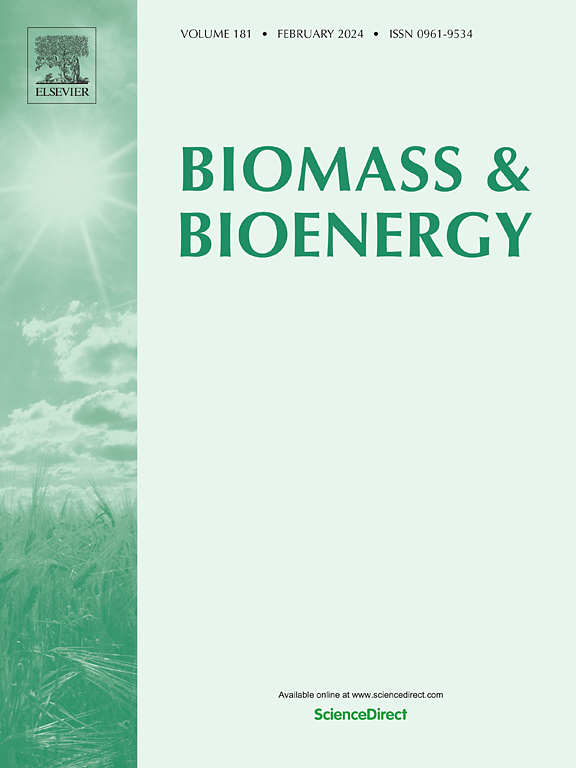生物塑料的热化学转化:聚乳酸(PLA) -废生物质混合物的释放气体分析和动力学因素
IF 5.8
2区 生物学
Q1 AGRICULTURAL ENGINEERING
引用次数: 0
摘要
聚乳酸(PLA)是全球产量最高的生物塑料,但却面临着生命末期处置的挑战。事实证明,热解是一种可行的选择,但回收产品的质量和价值并不理想。枣核(DP)是一种富含木质纤维素碎片化学成分的废弃副产品,可提供独特的富碳前体,在热解过程中非常理想。本研究旨在探讨添加 DP 对聚乳酸热解产物的协同效应。热重数据表明,聚乳酸与 DP 混合可促进炭的形成,在较低温度下启动降解,并将分解峰值温度(Tp)从 362 °C 降低到 343 °C。初级热解发生在(200-400 ℃)范围内,重量损失率为 75.5%,低加热速率避免了热滞后效应的产生,从而使 Tp 向低温方向移动。通过傅立叶变换红外光谱进行的化学结构分析表明,DP 的添加可通过聚乳酸的解聚作用促进受控的挥发性释放,从而使羟基、酚类和含酯基团的峰值更均匀、更明显。此外,DP 还能促进自由基反应,通过限制醛的形成来提高内酯的回收率。GCMS 分析表明,纯聚乳酸热解主要产生内酯(3,6-二甲基-1,4-二氧六环-2,5-二酮)。而与枣核一起进行的复制热解则使产品结构多样化,产生了碳氢化合物(庚烷和癸烷)、芳烃(二甲苯、甲苯和苯乙烯)和呋喃,这些物质在生物炼油厂、无铅燃料和石化工业中具有很高的价值。动力学分析表明,聚乳酸/DP 共热解混合物可将活化能(Ea)降低 18%,并降低热力学参数。本文章由计算机程序翻译,如有差异,请以英文原文为准。

Thermochemical conversion of bioplastics: Evolved gas analysis and kinetics factors for polylactic acid (PLA) - waste biomass mixture
Polylactic acid (PLA) is the highest produced bioplastic globally but facing end-life disposal challenges. Pyrolysis proves to be a viable option, but the recovered product profile is not desirable in terms of quality and value. Date Pits (DP), a waste byproduct chemically rich with lignocellulosic fragments, can provide unique carbon-rich precursors which are highly desirable in the pyrolysis process. This study aims to investigate the synergistic effect of DP addition on PLA pyrolysis products. Thermogravimetric data demonstrates that PLA mixing with DP promotes char formation, initiates degradation at lower temperatures, and decreases the peak decomposition temperature (Tp) from 362 °C to 343 °C. Primary pyrolysis occurs in the range of (200–400 °C) with 75.5 % weight loss and low heating rate shifts Tp toward lower temperatures by averting the development of the thermal lag effect. Chemical structure analysis through FTIR shows that DP addition promotes controlled volatile release through PLA depolymerization hence yielding more uniformed and distinguished peaks for hydroxyl, phenols, and ester-containing groups. Moreover, it promoted free radical reactions that enhanced lactide recovery by restricting aldehyde formation. GCMS profiling indicates that pure PLA pyrolysis majorly yieldes lactide (3,6-Dimethyl-1,4-dioxane-2,5-dione). While the copyrolysis with date pits diversifies this product profile with the production of hydrocarbons (heptane and decane), aromatics (xylene, toluene and styrene), and furans which are highly valued in biorefineries, as drop-in fuels and in petrochemical industries. Kinetic analysis shows that the PLA/DP co-pyrolysis mixture reduces activation energies (Ea) by 18 % and also reduces the thermodynamic parameters.
求助全文
通过发布文献求助,成功后即可免费获取论文全文。
去求助
来源期刊

Biomass & Bioenergy
工程技术-能源与燃料
CiteScore
11.50
自引率
3.30%
发文量
258
审稿时长
60 days
期刊介绍:
Biomass & Bioenergy is an international journal publishing original research papers and short communications, review articles and case studies on biological resources, chemical and biological processes, and biomass products for new renewable sources of energy and materials.
The scope of the journal extends to the environmental, management and economic aspects of biomass and bioenergy.
Key areas covered by the journal:
• Biomass: sources, energy crop production processes, genetic improvements, composition. Please note that research on these biomass subjects must be linked directly to bioenergy generation.
• Biological Residues: residues/rests from agricultural production, forestry and plantations (palm, sugar etc), processing industries, and municipal sources (MSW). Papers on the use of biomass residues through innovative processes/technological novelty and/or consideration of feedstock/system sustainability (or unsustainability) are welcomed. However waste treatment processes and pollution control or mitigation which are only tangentially related to bioenergy are not in the scope of the journal, as they are more suited to publications in the environmental arena. Papers that describe conventional waste streams (ie well described in existing literature) that do not empirically address ''new'' added value from the process are not suitable for submission to the journal.
• Bioenergy Processes: fermentations, thermochemical conversions, liquid and gaseous fuels, and petrochemical substitutes
• Bioenergy Utilization: direct combustion, gasification, electricity production, chemical processes, and by-product remediation
• Biomass and the Environment: carbon cycle, the net energy efficiency of bioenergy systems, assessment of sustainability, and biodiversity issues.
 求助内容:
求助内容: 应助结果提醒方式:
应助结果提醒方式:


